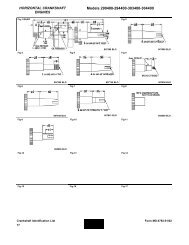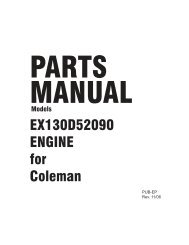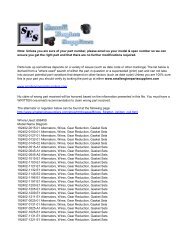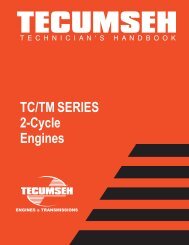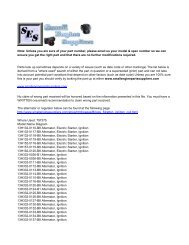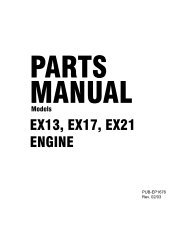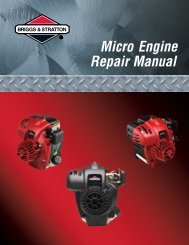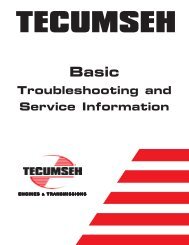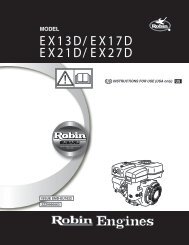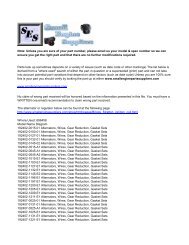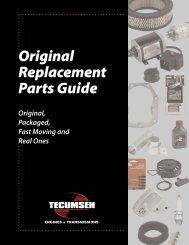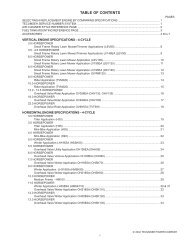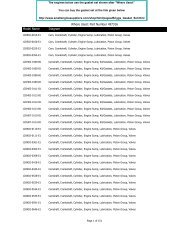3to 11hp 4-cycle l-head engines - Small Engine Suppliers
3to 11hp 4-cycle l-head engines - Small Engine Suppliers
3to 11hp 4-cycle l-head engines - Small Engine Suppliers
Create successful ePaper yourself
Turn your PDF publications into a flip-book with our unique Google optimized e-Paper software.
CHAPTER 3 CARBURETORS AND FUEL SYSTEMS<br />
GENERAL INFORMATION<br />
Tecumseh uses two basic types of carburetors, float and diaphragm type carburetors. Float type carburetors use a<br />
hollow float to maintain the operating level of fuel in the carburetor. Diaphragm type carburetors use a rubber-like diaphragm.<br />
One side is exposed to intake manifold pressure and the other side to atmospheric pressure. The diaphragm provides the<br />
same basic function (maintaining the proper fuel level in the carburetor) as the float.<br />
An advantage of the diaphragm carburetor over the float style is that the diaphragm carburetor will allow the engine to<br />
operate at a greater degree of tiltability.<br />
Tecumseh carburetors are identified by a manufacturing number and date code stamped on the carburetor as illustrated<br />
(diag. 1).<br />
When servicing carburetors, use the engine model and<br />
specification number to obtain the correct carburetor part<br />
number. An alternate method of finding the correct<br />
carburetor part number is to use the manufacturing number<br />
stamped on the carburetor and convert this number to a<br />
part number. In the carburetor section of the Master Parts<br />
Manual, Microfiche Catalog or computer parts look-up<br />
system, a cross reference chart will convert a carburetor<br />
manufacturing number to a Tecumseh part number.<br />
ALTERNATE LOCATION<br />
FOR MANUFACTURING<br />
NUMBER<br />
89 4F5<br />
Complete carburetor replacement may be accomplished<br />
with a standard service carburetor. A standard service<br />
carburetor is a basic carburetor that may require the use<br />
of original carburetor parts or additional new parts to adapt<br />
to the specification. An instruction sheet is provided with<br />
the new service carburetor or see “SERVICE” in this chapter.<br />
MANUFACTURING<br />
NUMBER<br />
89 4F5<br />
CARBURETOR<br />
DATE CODE<br />
1<br />
CAUTION: DRAIN THE FUEL INTO AN APPROVED CONTAINER OUTDOORS, AND AWAY FROM ANY OPEN<br />
FLAME OR COMBUSTION SOURCE. BE SURE THE ENGINE IS COOL.<br />
NOTE: Todays fuels can cause many problems in an <strong>engines</strong> performance, due to the fuels quality and short shelf life.<br />
Always check fuel as a primary cause of engine performance.<br />
1. Remove the air filter, heater box, or air cleaner assembly if applicable to visually check that the choke shutter<br />
completely closes or check to see if fuel comes out of the main nozzle during priming.<br />
2. If the fuel flow from the tank is adequate and no fuel is evident during priming, the carburetor will need to be<br />
removed for service. See “Service” in this chapter or consult the “Carburetion Troubleshooting” chart to diagnose<br />
carburetor symptoms. Improper fuel flow indicates the fuel, fuel line, filter or tank require cleaning or replacement.<br />
3. Check the engine compression using a commercially available compression tester and follow the tester’s<br />
recommended procedure. Low compression, a dry spark plug, adequate fuel flow, and a known good functional<br />
carburetor indicates an internal engine problem exists. See under “Troubleshooting.”<br />
4. A wet spark plug indicates fuel is being supplied by the carburetor. The engine may be flooded by a restricted<br />
air filter, carbon shorted or defective spark plug, excessive choking or over priming, improperly adjusted or<br />
defective carburetor. With the spark plug removed and a shop towel over the spark plug hole, turn the engine<br />
over slowly 3 or 4 times to remove excess gasoline from the engine cylinder.<br />
CAUTION: KEEP ALL COMBUSTIVE SOURCES AWAY. AVOID THE SPRAY FROM THE SPARK PLUG<br />
HOLE WHEN CRANKING THE ENGINE OVER.<br />
5. Replace the air filter if restricted or oil soaked. Replace the spark plug if questionable. Install the spark plug and<br />
high tension lead and try to start the engine.<br />
6. If the engine floods and fails to start, the carburetor will require service. See the proceeding “Carburetion<br />
Troubleshooting” chart for additional causes. If the carburetor is functioning properly the problem may be ignition<br />
timing related. See “Troubleshooting" under "Ignition”.<br />
7



